My two least favorite concepts in skiing are suffering and conquering. When we go hard in the mountains we are not suffering, we do it by choice, no one is inflicting this on us. And when we stand on top of mountains we do not conquer them. Backcountry ski blades help combat both of those ideas. They make it physically easier to access places, and they make it impossible to get into a self-serious mindset about your exploits.
Four months ago, I published this piece that explained why I wanted to try backcountry snowblading. Now, with most of a winter’s worth of blading behind me, including some of the coolest experiences on snow I’ve ever had, it’s time to publish my findings. The short version? I’m sold, I plan on having a pair of blades with pin bindings on them in my quiver for the foreseeable future.
I know, that sounds like anti-vaxxer conspiracy theory talk, and the fact that I’m about to type thousands of words trying to back up this idea doesn’t really help, but hey, I’m fully vaccinated and I think the results speak for themselves.
The Setup
Sego Ski Co. in Victor, Idaho made me a pair of custom Big Mountain Blades in December. They are 110 mm wide underfoot, fully rockered, with plenty of tip taper and a swallowtail. They are 108 cm long. That number is a bit of a point of contention, with some folks arguing that a blade must be less than 100 cm, while others maintain that the cutoff is 110 cm. I don’t really care. The blades I have are 108 cm long. Make me a wide, rockered pair that is 99 cm long and I’d rock those too.
I started out using Frischi Vipec bindings, without brakes, but quickly switched to Moment’s Voyager binding. I’m sold on these Moment-special ATK’s. They’re light, easy to use, and so far, bombproof. In my opinion, these are the gold standard for do-everything tech bindings.
For boots, I started out in my usual Scarpa Maestrale RS, but quickly realized it was overkill on the blades. Since then I’ve been using Scarpa’s F1 LT, with great results. I can drive real skis (184 cm Moment Deathwish Tour) with no problem, the walk mode is great, they have a very good ROM, and a smart feature set. I could probably get away with a full skimo race boot without issue, but those are expensive. Ideally, I’d like to get my hands on a pair of Atomic Backland Ultimates since their fit should work well for me, and it would be cool to shave 200 more grams off my boots.
For skins, I’m using half an old pair of Big Sky Mountain products Rover skins. They’re great. I love BSMP. I’m sure if enough people asked them, they’d sell blade-length skins. I may mess around with buying mohair race skins off a roll, but I have no complaints with my BSMP’s.
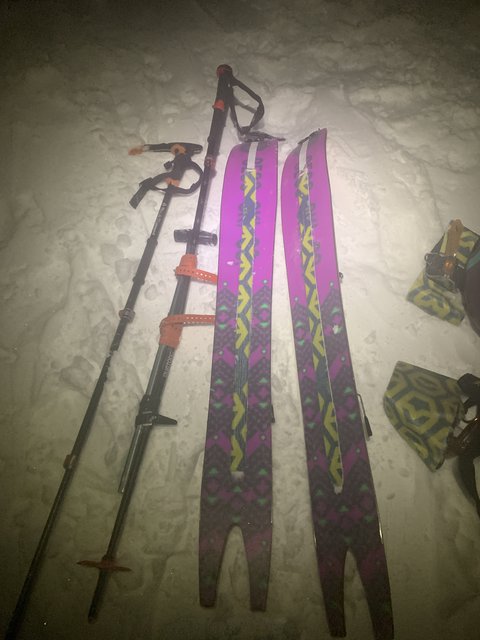
This is the "Brazilian" skin - perfect for long flat exits and approaches.
I’m using snowboard Z-poles. Z-poles suck and break. Buy three-piece telescoping poles, I’m sad I didn’t. Poles are important, you need something that’s durable on the up, and can fit in or on your pack for the down. Luckily snowboarders have spent years figuring this one out.
Downhill Capability
This is the question I get asked the most “Can you actually ski well on those things?” The answer is “Yes!” I can ski anything short of deep powder pillow lines as smoothly and fluidly as I do on my touring skis of choice, the Moment Deathwish Tour. I can ski them a lot harder than I can lighter skis, like the Salomon MTN Explore 95. I have skied everything from deep pow to icy crap on them, and I’ve never worried about getting down a line safely and competently. In many situations, like in tighter, steeper lines, I can stack turns more aggressively than I could on a real ski, and thus ski the line faster and harder, with less sideslipping.
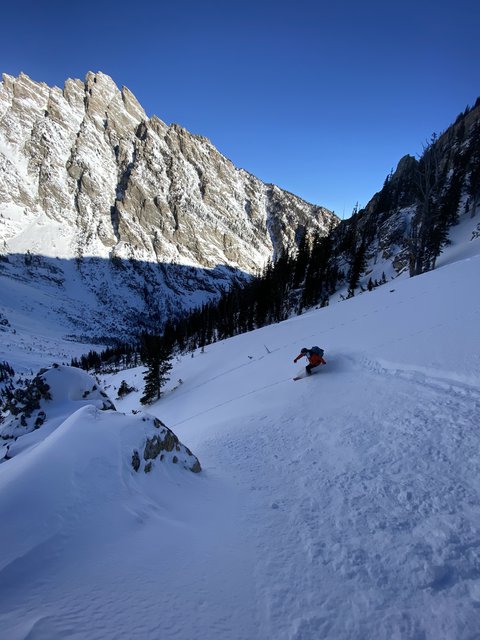
Photo by Scott Davidson, one of the first people who didn't discriminate against my blades.
Here’s an incomplete list of lines I was stoked to blade this winter, including their snow conditions:
- Split Decision (hot pow)
- Turkey Chute (tracked pow)
- Chuter-Buck (untracked pow)
- Peaches (deeeeep pow)
- Boyscout (4 times, everything from deep pow to ice)
- Son of Apocalypse (terrible firm snow)
- Birth Canal (terrible firm snow)
- The Skillet (thigh to boot deep pow)
I did not regret my decision to be on blades on any of those days. I never had a moment where I stopped mid-line and bemoaned my life choices. Many of those are lines I’ve skied on real skis before, and I skied them just as well (or better) on the blades. Well-designed blades go downhill well.
Inbounds I’ve found that on groomers I can ski them almost as fast as I could my regular skis. However, I’m no ex-racer, so that isn’t a great comparison. For chop and pow, I prefer normal skis inbounds. For slush, the blades rule.
Last weekend I skied the Skillet, one of the 50 Classic Ski Descents of North America on blades on a Friday. I spent Saturday hydrating, and then Sunday I ripped the same blades inbounds at Targhee, blasting groomers and the wiggle, and releasing my limited repertoire of park tricks. There is literally no other ski in the world I would do that on. There is no real ski setup that I would walk 20 miles on and then two days later go as fast I ever had down groomers and spin park jumps. I love how capable blades are.

Weight
Time for some nerd shit. Weights. This is what got me into blading in the first place. Here’s a chart of the weights of each component of two setups, my blades, and my regular touring setup, a 184 cm Deathwish Tour with Moment Voyager bindings. Boots are size 27 Scarpa Maestrale RS’s (with some mods) for the regular skis, and 27 Scarpa F1 LT’s for the blades. Weights are all for one foot of the setup, so multiply by two for the total weight.
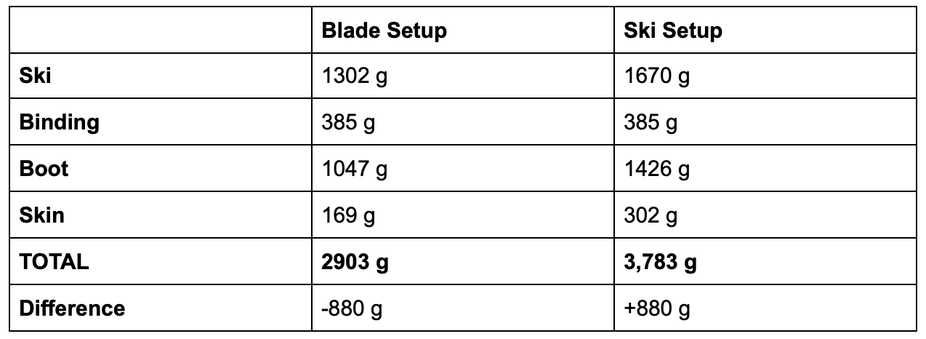
With the blade setup, I’m saving 880 g on each foot. To put that into context, a full 12 oz can of Tecate weighs 370 g. So to make my blade setup weigh as much as my regular setup I’d have to strap 2.4 cans of Tecate to each foot. That’s a lot of weight saved. If you apply the conventional wisdom that a pound on your foot equals five on your back, you could carry an extra 12 pack of Tecate for each foot in your pack on blades, and still burn the same amount of energy. 24 beers, or longer skis? Your choice.
And to be clear, I have a pretty light backcountry setup. For someone coming from alpine skiing, the Deathwish Tour/Voyager/Maestrale combo is about as light as you can go before you start really noticing a loss in skiing performance. So it’s not that my regular setup is portly, that blades are just a lot lighter.
Added to that astounding 880 g number, is the fact that the setup isn’t just lighter, it’s more efficient in other ways. Shorter skins mean less drag each step. Lighter boots have better walk modes, and tech fittings closer to the ball of my feet. It’s astounding how much quicker the blade setup feels over long days than my regular skis.
Finally, 1300 g a blade is really heavy. They do not need to be this heavy. Ideally the Full Send Ski Co. blades we’re working on developing will be around 800 g a foot. That’s in line with non-race skimo skis, and would get us another 500 g per foot, or 1.3 Tecates.
Ease of Use
Blades are easier to use in every scenario. Kick turns are easier to make, you never tangle your tips or tails. Bootpacking and scrambling with them on your pack is very easy, they barely stick out from it, they never catch on rocks or drag on the snow. They’re just plain easier. They make dealing with real skis feel like a foolish hassle.
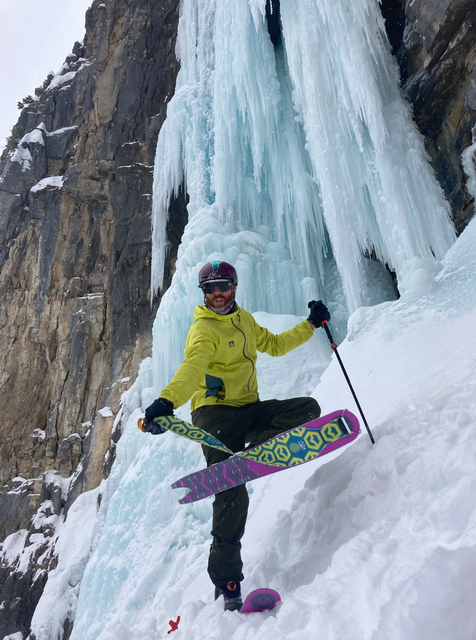
The only downside comes when breaking trail. In deep snow, they’re more work to break trail with than regular skis, and they leave spooned out tracks like a snowshoe would. Some partners really hate following in trail I break, others don’t care. And with these fully rockered blades, it’s challenging to break trail on steep, firmer slopes. Ideally the next iteration, with camber, will fix that.
Affect on Technique
When I started backcountry blading I had a few people message me with sentiments like “These are going to kill your form and make you a terrible skier.” To which I respond: “I already am a terrible skier, how will this make it worse?”
I learned to ski as an adult and have no formal training. I’m not a pretty skier or a good skier, but I’m a pretty good skier. I can ski down most things, have jumped off plenty of things, and like doing tricks sometimes. The blades have changed none of that. If anything, they’ve raised the bar for how I ski real skis. They open up tighter terrain for me, and when I ski 184 cm skis after time on the blades I feel like I have a much bigger margin for error when skiing fast and jumping off stuff. The blades aren’t my problem, my crappy fundamentals are.
Effective Edge
The big argument I’ve heard against blades in bigger terrain is their lack of effective edge. My own feelings on how people obsess over that arbitrary and inaccurate number aside, I don’t actually find it to be much of an issue. My blades are fully rockered, with very tapered tips. If they were 184 cm long they’d have a very short effective edge, as it is, they have barely any.
But edges are only as effective as the power you can direct to them. Here’s an example: you’re splitting firewood. You have one maul with a very heavy head, very sharp, great blade shape, etc. But the handle is flexy and weak, it puts splinters in your hands, and the head is always on the verge of flying off. That’s a ski with a long effective edge, but a crappy flex pattern, too-soft boot, and bad binding combo trying to apply power to that edge. The edge is great, but it’s not being used to its full potential.

The blades are more like a smaller axe with a comfortable, strong handle. Sure, the total splitting potential of the axe head is lower than that of the maul, but your boots and the ski’s flex have to do less work to transfer power to that head, so you’re splitting wood much more efficiently with the axe.
I have short effective edges on the blades, but they’re very predictable. I know right where they are, and how they will respond to input. I’m not overpowering my boots and overworking the stabilizing muscles in my legs. The system is more efficient and powerful than any combo of light boots and skis I’ve used. And with a little camber in version two, that power will only go up.
Are Blades Right for You?
Maybe. I would never own just blades. I like other aspects of skiing too much. They’re not very good for jumping off of stuff, and I live in a place where we get a lot of fresh snow to jump off of things into. For example, I only bladed one day in the month of February, otherwise, I spent my time skiing pow and popping pillows. Living in the Tetons I will always want to own a pair of pow skis with tech bindings.
That said, I don’t want to ski big lines on anything but blades. Full stop. If it involves a few thousand feet of climbing, a steep, narrow line with potentially variable snow, and maybe some rope work, I want to be on blades. A prime example is the Skillet. This line requires a 6-mile flat approach over Jackson Lake, followed by 5700 feet of skinning and booting. I don’t want to carry real skis across that lake, ever. That’s silly. On blades, I was able to mostly sort of keep pace with my skimo racer partner across the lake, ski the line in good style, and hoof it home with minimal exertion. I want to blade that line every season until global warming makes the ice too thin to skin over. I never want to ski it on anything longer than 108 cm.
If you can only have one touring setup, buy real skis. For most people, a Moment Deathwish Tour or Wildcat 108 Tour will do everything you need it to in the backcountry, from hippy pow to classic lines. If you can get a second setup though, consider blades, especially if you live somewhere like the Sierras or PNW where your big days often happen in firm snow and steep terrain. Blades are the ultimate volcano ski.
For me personally, I’ll be rocking a Moment Ghost Train for hippy pow days, and blades for big objectives for the foreseeable future.
What’s next?
“Lighter blades with camber” has been my mantra all winter, and hopefully it’s coming soon. Full Send Ski Co is working on blade 2.0 right now. I’ll hopefully get to test them this spring, and then they should be available for preorder this summer. If they are, they’ll be one of the first backcountry-specific blades to hit the commercial market.
My next blade setup will go full weight weenie: sub 160 g bindings, race skins that pull from the tip, the whole nine yards. I can’t wait to see how light it ends up being.
Reasons to push blading on the wider market
I know, I’ve already written an excessively long screed, but I think there’s still one looming question to answer: blades make me really happy, should other people try them?
Yes. Here’s why.
Environmental impact
Blades take roughly half as much material to make as regular skis. That’s good for the planet. Half as much wood, half as much composites, half as much epoxy, half as much impact. That doesn’t mean they’re half as much work to make, there’s still plenty of edge bending and space shaping and such that needs to happen no matter how long a ski is, but blades are more efficient to manufacture.
Ideally, you could build two pairs of blades at once in an extra-long press. Set it up so that each pair is laid up tail to tail, profiled from the same core, pressed with the same top-sheet, and then cut in half where the tips meet once they’ve been pressed. Two of those side by side and you’re pressing four blades at once, upping your capacity.
Less waste, less material used, happier planet.
Accessibility
The bigger argument for more widespread blade use is accessibility. We keep talking about wanting to make skiing more accessible to everyone, but we’re short on concrete ideas. Removing blade stigma is an easy one. It’s much, much easier to learn to snowlerblade in control at a resort than it is to learn to ski. How do I know? I learned to blade at the same time I was learning how to ski. Blading has a shorter learning curve before you’re linking turns and skiing groomers in control.
For some reason it’s only cool when already good skiers blade, and we mock beginner skiers on blades. That’s BS. There’s a prevailing argument that blading has a low top end, that you can’t progress beyond a certain point on blades. Maybe there is. I haven’t found it yet, and I think most beginner skiers don’t need to worry about that.
My biggest frustration when I see crowds of inexperienced skiers jamming up parking lots and lift lines is that we’re being forced into an artificially competitive mindset. The industry has led us to believe that other skiers are the enemy, not the monopolies that control it. Beginner skiers don’t need to make skiing worse for more accomplished folks. Blading would help with this.
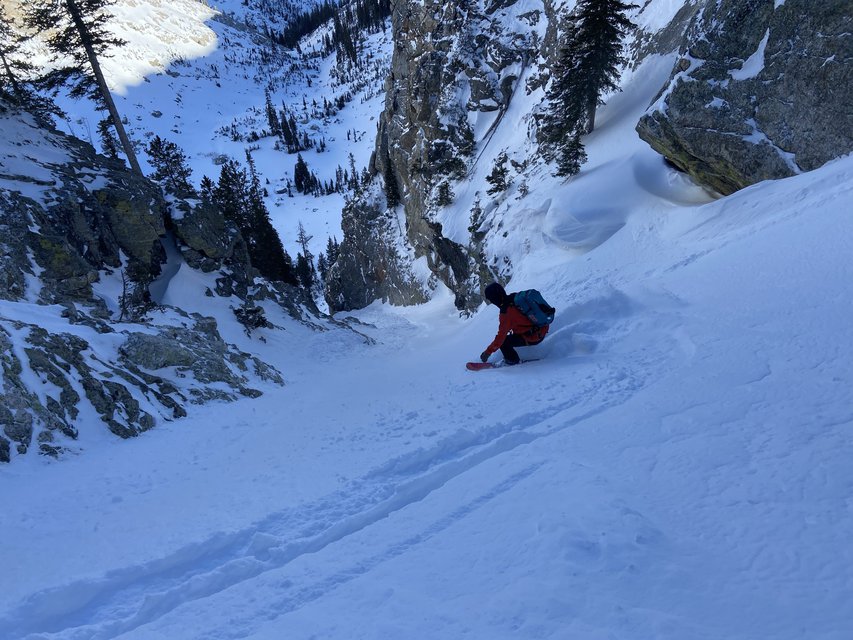
A big part of why beginner skiers are demonized is that they are often out of control and dangerous. And it makes sense. Rental skis are hard to turn, especially if it’s your second day out. Seriously, go ski some rental skis, they’re a pain in the butt. Forget hockey stopping on them, or navigating lift lines. We get annoyed at beginners because they run into us, they present a hazard. Blades make them less of a hazard. If you’re going on your once-a-year ski vacation to wander around on groomers, why not do it on gear that’s easier to stay in control of? They even fit in your trunk, so Instagram doesn’t have to make fun of your sideways roof box.
And they require less precise fitting boots to drive. My ideal inbounds blade setup would be those Apex snowboard boot binding things, with blades. All the comfort, none of the hassle. Carry your blades onto the plane, drive your rental car to the hill in your snowboard boots, and make controlled turns down groomers instead of endangering everyone else. Is this blasphemous against all the norms of the ski industry? Maybe, but who cares, what we’ve been doing so far hasn’t been working.
Add to that the rise in inbounds uphill travel. More folks are skinning up resorts to ski down groomers than ever before. And it makes sense, it’s a nice way to get some exercise and get out in the mountains. But why are these folks hauling real skis up and down the hill? Grab your blades from the closet, slip into some comfortable boots, jog your fitness lap, carve the groomer back down and get to work. Blades are the ultimate inbounds skinning setup.
More widespread ski blade use would help make skiing more accessible to beginners, and make the mountain safer for everyone.
Conclusion
For too long backcountry ski blading has been a gimmick that experienced skiers use to prove how badass they are. “Oh, you skied that sidecountry line? I bet I can blade it!”
I’m not impressed, backcountry blading is easier, that’s the whole point. This winter I’ve climbed and skied a bunch of fun lines with my snowlerblades. The climbs were easier, and the descents were funner. That’s a win in my book. Give it a shot, you might just fall for blading too.

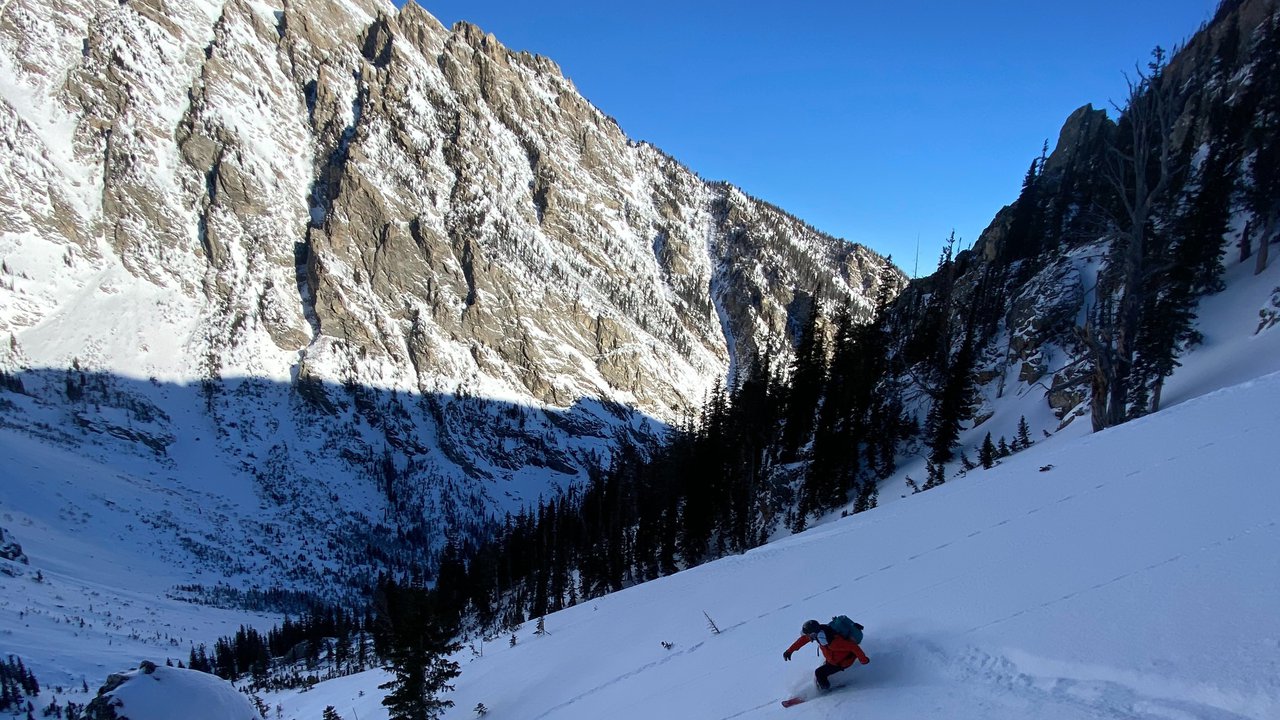
Comments